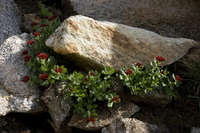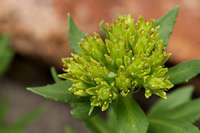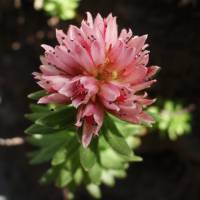Herbs, perennial (dying back in winter to rootstock), not viviparous, 0.3-6 dm, glabrous [pubescent]. Stems a rootstock with apex mostly above ground, erect, spreading, or decumbent, commonly branching to form clumps, fleshy, with brown scalelike [or green] leaves; flowering stems from axils of brown scale-leaves on stout rootstock partly above ground. Leaves persistent, cauline, alternate, sessile, subclasping basally; blade elliptic to ovate or oblanceolate to linear, obovate, or oblong, laminar (mostly to 1 mm thick), 0.5-5.5 cm, somewhat fleshy, base not spurred, margins entire or toothed; veins not conspicuous. Inflorescences cymose or spikelike to subcapitate. Flowers bisexual or unisexual, erect, 4-6-merous; sepals connate basally, all alike (unequal in R. rosea); petals erect or spreading, distinct, greenish, white, rose, dark red, or yellowish; calyx and corolla not circumscissile in fruit; nectaries quadrate to linear; stamens 2 times as many as sepals, epipetalous; filaments mostly adnate to corolla at base; pistils erect, nearly distinct; ovary base straight; styles 2+ times shorter than ovary. Fruits erect. Seeds oblanceoloid or pyriform, ribbed, finely cross-ribbed.
In Rhodiola, inflorescences are borne in axils of scale leaves on the rootstocks, which are partly above ground. They are thinner and leafier than those of Hylotelephium. This treatment largely follows R. T. Clausen (1975), except that he made Rhodiola a subgenus of Sedum.
PLANT: Perennial herbs, ours glabrous, with rootstocks bearing axillary annual floral stems.
LEAVES: alternate, subclasping, often toothed, broad and rather thin, those of rootstocks scale-like in ours.
FLORAL STEMS: lateral, overtopping rootstocks, bearing the foliage leaves; inflorescence cymose or in ours spikelike or subcapitate.
FLOWERS: perfect or imperfect, 4-6-merous, in ours perfect- mostly 5-6-merous; petals separate, in ours nearly erect; stamens twice as many as sepals; pistils erect, separate.
FOLLICLES: erect, many-seeded.
NOTES: Ca. 40 spp. in N Hemisphere, mostly montane and subarctic, mostly c Asia (Greek rhodon = rose, from odor of rootstock in type species).
REFERENCES: Moran, Reid. 1994. Bixaceae. J. Ariz. - Nev. Acad. Sci. Volume 27, 190-194.







